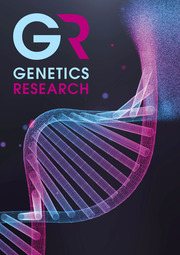Crossref Citations
This article has been cited by the following publications. This list is generated based on data provided by
Crossref.
1995.
Outcrossing rates and correlated matings in a predominantly selfing freshwater snail.
Proceedings of the Royal Society of London. Series B: Biological Sciences,
Vol. 262,
Issue. 1364,
p.
119.
Doums, Claudie
Labbo, Rabiou
and
Jarne, Philippe
1996.
Stability and genetic basis of variability of phally polymorphism in natural populations of the self-fertile freshwater snailBulinus truncatus.
Genetical Research,
Vol. 68,
Issue. 1,
p.
23.
1996.
The reproductive biology and genetics of island plants.
Philosophical Transactions of the Royal Society of London. Series B: Biological Sciences,
Vol. 351,
Issue. 1341,
p.
725.
Doums, Claudie
Viard, Frederique
Pernot, Anne-Françoise
Delay, Bernard
and
Jarne, Philippe
1996.
INBREEDING DEPRESSION, NEUTRAL POLYMORPHISM, AND COPULATORY BEHAVIOR IN FRESHWATER SNAILS: A SELF-FERTILIZATION SYNDROME.
Evolution,
Vol. 50,
Issue. 5,
p.
1908.
Charlesworth, Brian
and
Guttman, David S.
1996.
Reductions in genetic variation inDrosophila andE. coli caused by selection at linked sites.
Journal of Genetics,
Vol. 75,
Issue. 1,
p.
49.
Jabbour-Zahab, R
Pointier, J.P
Jourdane, J
Jarne, P
Oviedo, J.A
Bargues, M.D
Mas-Coma, S
Anglés, R
Perera, G
Balzan, C
Khallayoune, K
and
Renaud, F
1997.
Phylogeography and genetic divergence of some lymnaeid snails, intermediate hosts of human and animal fascioliasis with special reference to lymnaeids from the Bolivian Altiplano.
Acta Tropica,
Vol. 64,
Issue. 3-4,
p.
191.
Lymbery, A. J.
Constantine, C. C.
and
Thompson, R. C. A.
1997.
SELF-FERTILIZATION WITHOUT GENOMIC OR POPULATION STRUCTURING IN A PARASITIC TAPEWORM.
Evolution,
Vol. 51,
Issue. 1,
p.
289.
Viard, F.
Doums, C.
and
Jarne, P.
1997.
Selfing, sexual polymorphism and microsatellites in the hermaphrodititic freshwater snailBulinus truncatus.
Proceedings of the Royal Society of London. Series B: Biological Sciences,
Vol. 264,
Issue. 1378,
p.
39.
Viard, F.
Justy, F.
and
Jarne, P.
1997.
THE INFLUENCE OF SELF-FERTILIZATION AND POPULATION DYNAMICS ON THE GENETIC STRUCTURE OF SUBDIVIDED POPULATIONS: A CASE STUDY USING MICROSATELLITE MARKERS IN THE FRESHWATER SNAILBULINUS TRUNCATUS.
Evolution,
Vol. 51,
Issue. 5,
p.
1518.
Coutellec-Vreto, Marie-Agnès
Madec, Luc
and
Guiller, Annie
1997.
Selfing and biparental inbreeding: a mating system analysis in Lymnaea peregra (Gastropoda: Lymnaeidae).
Heredity,
Vol. 79,
Issue. 3,
p.
277.
Städler, T.
and
Jarne, P.
1997.
Evolutionary Ecology of Freshwater Animals.
p.
231.
Doums, Claudie
Viard, Frédérique
and
Jarne, Philippe
1998.
The evolution of phally polymorphism.
Biological Journal of the Linnean Society,
Vol. 64,
Issue. 3,
p.
273.
Blouin, M.S.
1998.
Mitochondrial DNA diversity in nematodes.
Journal of Helminthology,
Vol. 72,
Issue. 4,
p.
285.
Charlesworth, Brian
and
Charlesworth, Deborah
1998.
Mutation and Evolution.
Vol. 7,
Issue. ,
p.
3.
Tuan, Roseli
and
Simões, Luiz Carlos Gomes
1998.
Effect of self-fertilization on Biomphalaria tenagophila (Orbigny, 1835) (Pulmonata: Planorbidae).
Genetics and Molecular Biology,
Vol. 21,
Issue. 4,
p.
477.
Brazeau, Daniel A
Gleason, Daniel F
and
Morgan, Michael E
1998.
Self-fertilization in brooding hermaphroditic Caribbean corals: Evidence from molecular markers.
Journal of Experimental Marine Biology and Ecology,
Vol. 231,
Issue. 2,
p.
225.
Jordaens, K.
Backeljau, T.
Ondina, P.
Reise, H.
and
Verhagen, R.
1998.
Allozyme homozygosity and phally polymorphism in the land snail Zonitoides nitidus (Gastropoda, Pulmonata).
Journal of Zoology,
Vol. 246,
Issue. 1,
p.
95.
Kirkpatrick, Mark
and
Jarne, Philippe
2000.
The Effects of a Bottleneck on Inbreeding Depression and the Genetic Load.
The American Naturalist,
Vol. 155,
Issue. 2,
p.
154.
Miller, Mark P
Stevens, Larry E
Busch, Joseph D
Sorensen, Jeff A
and
Keim, Paul
2000.
Amplified fragment length polymorphism and mitochondrial sequence data detect genetic differentiation and relationships in endangered southwestern U.S.A. ambersnails (Oxylomaspp.).
Canadian Journal of Zoology,
Vol. 78,
Issue. 10,
p.
1845.
Anderson, Timothy J. C.
Haubold, Bernhard
Williams, Jeff T.
Estrada-Franco§, Jose G.
Richardson, Lynne
Mollinedo, Rene
Bockarie, Moses
Mokili, John
Mharakurwa, Sungano
French, Neil
Whitworth, Jim
Velez, Ivan D.
Brockman, Alan H.
Nosten, Francois
Ferreira, Marcelo U.
and
Day, Karen P.
2000.
Microsatellite Markers Reveal a Spectrum of Population Structures in the Malaria Parasite Plasmodium falciparum.
Molecular Biology and Evolution,
Vol. 17,
Issue. 10,
p.
1467.


